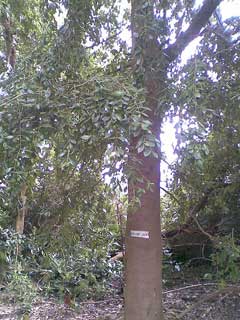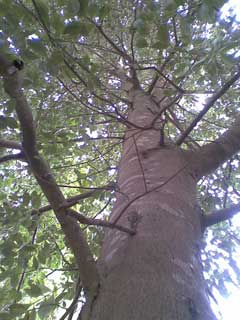 |
|
http://commons.wikimedia.org/wiki/User:Vernon39 |
 |
| http://commons.wikimedia.org/wiki/User:Vernon39 |
Translate this page:
Summary
Physical Characteristics

 Laurelia sempervirens is an evergreen Tree growing to 15 m (49ft) by 15 m (49ft).
Laurelia sempervirens is an evergreen Tree growing to 15 m (49ft) by 15 m (49ft).
See above for USDA hardiness. It is hardy to UK zone 9. It is in leaf all year, in flower in April. The species is dioecious (individual flowers are either male or female, but only one sex is to be found on any one plant so both male and female plants must be grown if seed is required). and is pollinated by Insects. The plant is not self-fertile.
Suitable for: light (sandy), medium (loamy) and heavy (clay) soils. Suitable pH: mildly acid, neutral and basic (mildly alkaline) soils. It can grow in semi-shade (light woodland) or no shade. It prefers moist soil.
UK Hardiness Map
US Hardiness Map
Synonyms
L. aromatica. non Poir. L. serrata.
Plant Habitats
Woodland Garden Secondary; Dappled Shade;
Edible Uses
Edible Parts:
Edible Uses: Condiment
The bark and leaves are used as a spice[183]. The fruit and the seed are used[2, 46, 61, 177].
References More on Edible Uses
Medicinal Uses
Plants For A Future can not take any responsibility for any adverse effects from the use of plants. Always seek advice from a professional before using a plant medicinally.
Nervine Skin Stomachic VD
Nervine, skin. It is also used in the treatment of colds, paralysis, stomach problems and VD[139].
References More on Medicinal Uses
The Bookshop: Edible Plant Books
Our Latest books on Perennial Plants For Food Forests and Permaculture Gardens in paperback or digital formats.

Edible Tropical Plants
Food Forest Plants for Hotter Conditions: 250+ Plants For Tropical Food Forests & Permaculture Gardens.
More

Edible Temperate Plants
Plants for Your Food Forest: 500 Plants for Temperate Food Forests & Permaculture Gardens.
More

More Books
PFAF have eight books available in paperback and digital formats. Browse the shop for more information.
Shop Now
Other Uses
Wood
Wood - not durable, malodorous if cut across the grain. Used in construction[139]. It burns well but gives little heat[139].
Special Uses
Scented Plants
References More on Other Uses
Cultivation details
Succeeds in sun or semi-shade in any moderately fertile soil, including a limey soil, so long as it does not dry out in the growing season[200]. Requires a warm position sheltered from cold winds[200]. This species is not very hardy in Britain, tolerating temperatures down to about -5°c[200]. It succeeds outdoors in the mildest areas of the country[1], growing well and flowering regularly in Cornwall[11, 59]. Another report says that plants have withstood temperatures down to -11°c[104]. The foliage is very aromatic[188]. Closely related to L. serrata[182]. Another report says that L. serrata is a synonym for this species[200]. Plants are often dioecious, male and female plants will need to be grown if fruit and seed is required.
References Carbon Farming Information and Carbon Sequestration Information
Temperature Converter
Type a value in the Celsius field to convert the value to Fahrenheit:
Fahrenheit:
The PFAF Bookshop
Plants For A Future have a number of books available in paperback and digital form. Book titles include Edible Plants, Edible Perennials, Edible Trees,Edible Shrubs, Woodland Gardening, and Temperate Food Forest Plants. Our new book is Food Forest Plants For Hotter Conditions (Tropical and Sub-Tropical).
Shop Now
Plant Propagation
Seed - sow February or March in a warm greenhouse. Germination rates are variable[78]. When they are large enough to handle, prick the seedlings out into individual pots and grow them on in the greenhouse for at least their first winter. Plant them out into their permanent positions in late spring or early summer, after the last expected frosts, and consider giving them some protection from the cold for their first winter or two outdoors. Cuttings of half-ripe wood, 5 - 8cm with a heel, July/August in individual pots in sandy soil in a frame. Keep them moist. Fair percentage[78]. Layering in spring[78].
Other Names
If available other names are mentioned here
Native Range
SOUTHERN AMERICA: Chile
Weed Potential
Right plant wrong place. We are currently updating this section.
Please note that a plant may be invasive in one area but may not in your area so it's worth checking.
Conservation Status
IUCN Red List of Threatened Plants Status :

Growth: S = slow M = medium F = fast. Soil: L = light (sandy) M = medium H = heavy (clay). pH: A = acid N = neutral B = basic (alkaline). Shade: F = full shade S = semi-shade N = no shade. Moisture: D = dry M = Moist We = wet Wa = water.
Now available:
Food Forest Plants for Mediterranean Conditions
350+ Perennial Plants For Mediterranean and Drier Food Forests and Permaculture Gardens.
[Paperback and eBook]
This is the third in Plants For A Future's series of plant guides for food forests tailored to
specific climate zones. Following volumes on temperate and tropical ecosystems, this book focuses
on species suited to Mediterranean conditions—regions with hot, dry summers and cool, wet winters,
often facing the added challenge of climate change.
Read More
Expert comment
Author
(Ruiz.&Pav.)Tul.
Botanical References
11200
Links / References
For a list of references used on this page please go here
Readers comment
| Add a comment |
|
If you have important information about this plant that may help other users please add a comment or link below. Only comments or links that are felt to be directly relevant to a plant will be included. If you think a comment/link or information contained on this page is inaccurate or misleading we would welcome your feedback at [email protected]. If you have questions about a plant please use the Forum on this website as we do not have the resources to answer questions ourselves.
* Please note: the comments by website users are not necessarily those held by PFAF and may give misleading or inaccurate information.
To leave a comment please Register or login here All comments need to be approved so will not appear immediately.
|
Subject : Laurelia sempervirens
|
|
|
|